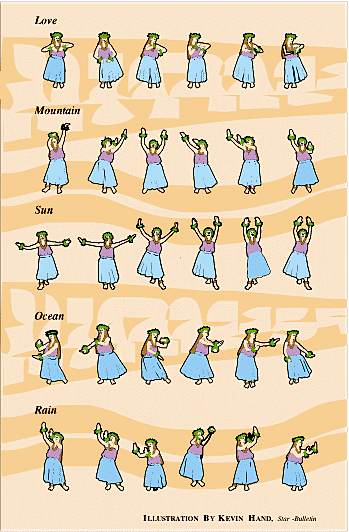




"I'm a feet person," said the kumu hula, whose Ka Pa Hula O Kauanoe O Wa'ahila performs at the 34th annual Merrie Monarch Festival hula competition this weekend. "You dance with your feet. You don't dance with your hands really. It's your feet that take you around, not your hands."
 Hula choreography is about more than hands. It can embrace feet as well as lyrical body motions reflecting nature, and dynamic change in the pursuit of perfection.
Hula choreography is about more than hands. It can embrace feet as well as lyrical body motions reflecting nature, and dynamic change in the pursuit of perfection.
"When you put your feet down strong, you control your body for the hula," said the 85-year-old doyenne who's been crafting dances for more than six decades. "But if you're on your toes, you're kinda little wobbly, yeah."
She teaches dancers to plant both feet flat and sway into their steps. She emphasizes a natural, controlled hip movement, as if dancers are floating across the stage. The feet don't skid, they don't tap, they don't jerk. The torso is pa'a (not bobbing) and hand movements are very subtle.
Hula choreography depends on one's tradition, which can differ with island, 'ahupua'a (district) and hula genealogy. Loebenstein's hula lineage includes hula master Kamawae of Wailuku, Maui; her mother, kumu Ida Ka'aihue Kai'anui Long of Kahului, Maui; and Oahu masters "Mama" Lydia and "Papa" David Bray, Henry Pa and Aunty Lena Nahulu Guerrero.
Loebenstein and her adopted granddaughter, Maelia Lani Kahanuola Loebenstein, collaborate; theirs is a unique choreography of choreographers. They dream. They find, research, translate and study a chant. Aunty Mae works out the beat on her ipu (gourd drum). She is the mind and granddaughter Maelia is the body while they work out the feet and hand movements.

The number of dancers influenced the choreography. Ka Pa Hula O Kauanoe O Wa'ahila usually takes to the Merrie Monarch 16 young women aligned in four rows of four dancers each. This year the halau prepared 17 dancers, arranged in rows of three, four, five and five -- "just like the bow of a ship," Aunty Mae said.
"When we did the first verse, I remember she was playing the beat and chanting it," recalled Maelia Loebenstein, who was crowned 1993 Miss Aloha Hula. The beat seemed to call for a "pitch-and-roll movement" by the dancers, she said.
"Sometimes it's scary because we get it almost the same time," the elder Loebenstein said about their seamless collaboration. "We don't talk to each other and yet we get together and bang, bang, bang."
Choreography at Halau Hula Olana features more movement and flourish than at Loebenstein's halau. Kumu hula Olana Ai's hula genealogy includes her grandmother Annie Kaleikaulana Lake, who had kapu (sacred) hula training in Kihei, Maui; and her mother Blossom Kailiponi Clark Kaipo, a city parks kumu for more than 40 years in Wahiawa.
"We're reflecting the movement of nature," Ai said. "You see the tree or the palms move. The dancer's job is to reflect that she is part of this movement and her spirit should be still swaying if she's doing a tree, or high if she's doing a mountain."
And then there's the dynamic choreography of kumu hula John Kaha'i Topolinski of Ka Pa Hula Hawai'i. His genealogy includes Aunty Maiki Aiu Lake and Mary Kawena Puku'i.
Topolinski has been known to change his choreography from day to day, sometimes overhauling a whole dance format.
"I call it a growing process. That's very Hawaiian. That's how I learned hula, how I learned (outrigger canoe) paddling," he said. "In our halau it takes about four years to get the style and hang of it all so that a dancer is versatile.

His dancers may become frustrated when they master a dance, then have to learn a re-choreographed version.
"Students want it right away. It takes time to achieve perfection. This is a fast-food generation. It doesn't come that way with us; so there's a large turnover. That's OK."
More than hands, hula choreography can embrace dreams and feet, the lyrical motion of nature and the dynamic pursuit of perfection. And perhaps the most important aspect is spirituality. For a choreographer, as for a dancer, spiritual openness and purity keep the lines clear to the muses and creativity.
Aunty Mae Loebenstein said, "Your way of living -- spiritually, the way you live, the way you carry on -- has a lot to do with your dancing. If you take hula seriously, you cannot make kapulu (sloppy), any kine.
"Everybody who's in the hula world, who takes it seriously, all go through this -- nice things, this (spiritual) help, because I guess to the Hawaiians it was part of a religion.
"It was sacred. It came more out of the spiritual."

Place: Edith Kanaka'ole All-Purpose Tennis Stadium, Hilo
Time: 6 to 11 p.m. Thursday, Miss Aloha Hula solo competition; 6 to 11 p.m. Friday, group competition in hula kahiko (traditional); 6 p.m. to midnight Saturday, group hula 'auana (modern) and awards
Admission: $5; tickets available for Thursday's Miss Aloha Hula competition only
Call: 935-9168 on the Big Island
TV: KITV4 televises all three nights live with co-hosts Paula Akana and Kimo Kahoano. Also, "Backstage at the Merrie Monarch" airs 7 p.m. Wednesday, KITV4